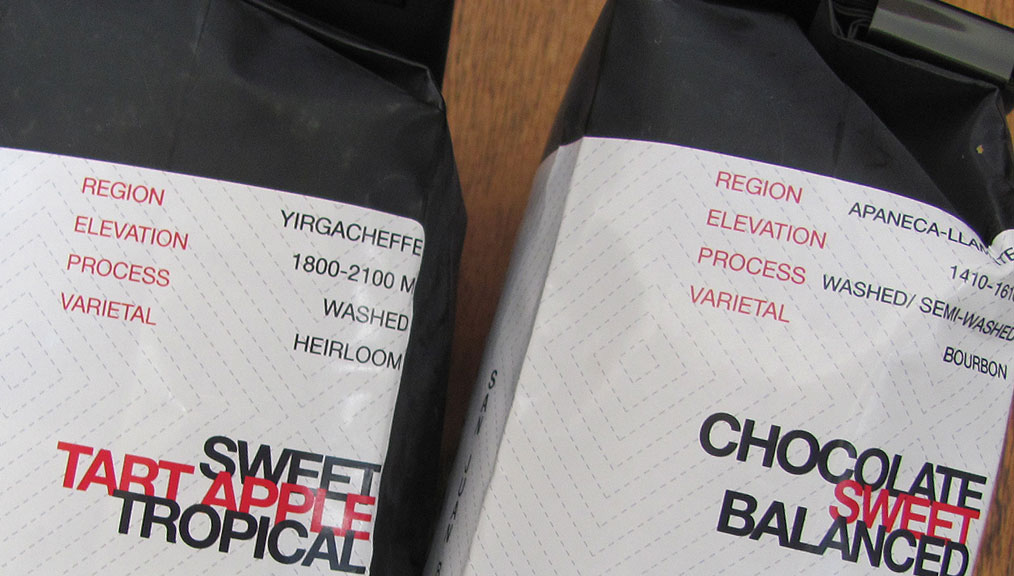(Photo: Cynthia Meadors.)
[C]offee has never really been just coffee: it’s been Sumatra Mandheling, Colombia Excelso, Guatemala SHB, and Tanzania peaberry. But now we know so much more about most coffee we sell, beyond merely provenance or type. Today there is enough connectivity and transparency throughout the supply chain that we can call single-origin coffees by their names. But what name? The name of the town, of the farm, or of the farmer? What if we know the name of one but not the other? How do we clearly share the information we do (and don’t) have with our peers and consumers?
When we identify a coffee by name—on a retail bag, café signboard, or a company website—we have to make sure we know why we are calling it by that name. Let’s take a moment to ask ourselves if the names by which we call coffees are just interesting ways to identify each SKU or if they actually indicate from where and whom each coffee comes.
Ikea has continually demonstrated how much more connected consumers feel to products when they can call them by name rather than descriptor. Ordering the Rissna feels more personal than buying coffee table 873. This kind of naming works for furniture because there is no risk of misrepresenting its origin by calling a table Rissna (a village in Sweden). We must take care with coffee, though; it does not all issue from the same warehouse.
If we title an offering Colombia La Esperanza, for example, we have to make sure we are clear whether we are just giving it a name to make it more personal than Colombia Excelso and as memorable as the Rissna, or if we are actually trying to tell the consumer something. Customers are not mind readers; they will assume a name is just a name until we explain otherwise. (Try to remember when you first learned that Yirgacheffe was a place and not a plant or an animal.)
Identifying a coffee online, on the shelf, or on bar as Colombia La Esperanza with no supporting information in the form of a coffee bio, an info card, or a chalkboard blurb is completely fine. It simply indicates a way to identify the product. But understand this name alone does not actually communicate any information to the customer. Without supporting information, “La Esperanza” could refer to the lot, the farm, the community, or Colombians’ general attitude of optimism.
As an industry we must challenge ourselves to use the names we assign our coffees not just as product differentiators, but as commitments to teaching staff and consumers that these lots of coffee originate from specific and nameable mills, communities, farms, and people.
Colombia La Esperanza could come from anywhere within Colombia’s borders—just like a Colombia Excelso. For decades, Colombia’s mountains were ravaged by civil war and made unsafe for agriculture; as a result, there are an untold number of farms in Colombia named esperanza, which means hope. To explain which Colombia La Esperanza a given retailer is serving requires more comprehensive information, in the form of packaging, signage, info cards, videos, podcasts, farm photos, or something else.
A customer who grabs a cup of Colombia La Esperanza on the way to work is about as connected to her coffee as she is to the Rissna she ordered online. But if that customer was provided a blurb on the chalkboard and a map attached to the airpot, she could learn that she was drinking a cup of coffee from Finca La Esperanza outside the town of Pitalito in Huila, one of Colombia’s southernmost departments.
If we want Colombia La Esperanza to really speak to consumers about provenance and origin in a more meaningful way than Colombia Excelso does, we have to figure out how to share the rest of the details that give the name meaning. Companies who value minimalist design in their shops and branding might worry that maps, charts, or paragraphs are overwhelming or off-putting to consumers. I argue that those in-depth details are exactly what we need to share if we want to fully communicate a coffee’s roots.
We invest quite a lot of time, money, and passion sourcing and serving a specific Colombia La Esperanza instead of Colombia Excelso, and it is worth fostering invested, interested customers by sharing what we learn from all that work. A customer who knows not just that her coffee is called La Esperanza but why is the customer who understands that her morning beverage holds a unique value, the kind worth seeking out, telling her friends about, and paying a premium for.
As an industry we must challenge ourselves to use the names we assign our coffees not just as product differentiators, but as commitments to teaching staff and consumers that these lots of coffee originate from specific and nameable mills, communities, farms, and people.
When I read a detailed provenance like “Miller Olaya’s coffee from Finca La Esperanza in San Isidro de Acevedo, City of Pitalito, Department of Huila, Colombia” on a bag of beans, bulletin board, or website, it gives me hope that the industry is genuinely committed to responsible, transparent sourcing, rather than just to exciting names.
If we name a coffee after the person or place, we have to remember to show that it’s more than just a title for the bag. If we don’t, a name is just a name, and we’re right back at the Excelso we were trying to move beyond.
—Rachel Northrop has traveled extensively at origin and is now a sales rep with Ally Coffee’s specialty importing division.















